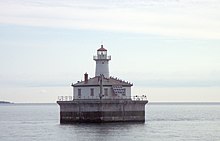 The light in 2001 (note the solar panels that provide the current power) | |
 | |
| Location | Lake Huron, Michigan |
|---|---|
| Coordinates | 45°40′47.3″N 84°26′6″W / 45.679806°N 84.43500°W |
| Tower | |
| Constructed | 1929 |
| Foundation | Concrete Crib |
| Construction | Reinforced concrete and steel |
| Automated | 1930 |
| Height | 36 feet (11 m)[1] |
| Shape | square building; frustum of a cone tower |
| Markings | White with red trim |
| Heritage | National Register of Historic Places listed place |
| Fog signal | HORN: 1 blast ev 15 s (2s bl)[4] Diaphone |
| Light | |
| First lit | 1930 |
| Focal height | 55 feet (17 m)[2][3] |
| Lens | Fourth-order Fresnel lens[5] (original), 9.8-inch (250 mm) Tidelands acrylic optic Fresnel lens (current) |
| Range | 9 nautical miles (17 km; 10 mi)[4] |
| Characteristic | Occulting W 4 seconds Operates year round. |
Fourteen Foot Shoal Light Station | |
| NRHP reference No. | 05000742[6] |
| Added to NRHP | July 27, 2005 |
The lighthouse at Fourteen Foot Shoal was named to note that the lake is only 14 feet (4.3 m) deep at this point, which is a hazard to navigation, ships and mariners.
This light is located at the northern end of Lake Huron, Michigan, US, where it is necessary for boats heading to Chicago to pass through a narrow strait and still avoid shallow water. The most common path is to go south of Bois Blanc Island (Michigan). In this channel, the Poe Reef Light marks the northern end of the safe channel and the Fourteen Foot Shoal light marks the southern side of the channel.
- ^ "Seeing The Light - Lighthouse Tower Heights". September 18, 2000. Archived from the original on September 18, 2000.
- ^ National Park Service, Maritime Heritage Program, Inventory of Historic Lights, Fourteen Foot Shoal Light.
- ^ Pepper, Terry. "Database of Focal Heights". Seeing the Light. terrypepper.com. Archived from the original on August 30, 2008.
- ^ Pepper, Terry. "Database of Original Lenses". Seeing the Light. terrypepper.com. Archived from the original on September 18, 2000.
- ^ "National Register Information System". National Register of Historic Places. National Park Service. March 13, 2009. Archived from the original on July 25, 2008. Retrieved August 3, 2010.